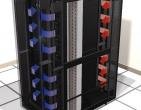Sales for close-coupled data center cooling products are not producing the double-digit growth once hoped for, according to a report by market analyst IHS.
The report found that row/rack revenues fell by roughly 6% in 2013 compared with a perimeter cooling market decline of 3%.
In-row and rack cooling, products are typically used as standalone cooling solutions in small data centers or as supplementary cooling in high-density applications.
Author of Data Center Cooling 2014 Elizabeth Cruz said there are two explanations for the unexpected data center market dynamics: outsourcing is on the increase and supplementary cooling is no longer needed.
“Increasingly companies outsource their small data centers to colocation or cloud providers, which use traditional room cooling,” Cruz said.
“Supplementary cooling of high-density areas is not posing much opportunity for growth either.”
The death of this industry sector could be created as row and rack densities change, according to the report.
Currently row/rack products offer significant energy savings once rack densities approach the 8-10kW range.
At that point, it becomes more efficient to install a row/rack product than to increase the flow of air from a computer room air conditioning unit or computer room air handling unit to cool down a hot spot in a data center.
But with average rack densities still in the sub-5kW range, the operational savings from a row/rack product are not being realized and the justification for the higher investment cost is difficult to make.
The fact that many data centers still operate at higher densities has underpinned the moderate growth projections for the next five-years.
However, these are becomingly increasingly rare as the modern taste for low power density data centers takes hold.
According to the analyst, the sluggish data center market does not help.
It said there has been a contraction of revenue in the past two years across all segments of data center infrastructure.
“The economy is still a major factor in companies putting off large capital investments like data center builds,” Cruz said.
“And companies are consolidating their data center operations by outsourcing to colocation or cloud providers.”
This consolidation leads to more optimized data centers which maximize efficiency and reduce the need for power and cooling, Cruz said.
The growing adoption of virtualization and improvements in server technology will only further the agony for manufacturers of cooling and cooling backup systems, Cruz predicted.
However, in the medium term, IHS predicts a return to growth in the data center market, as consolidation and technology improvements can no longer absorb the increased digitization and resulting compute, storage and processing needs.
“When the market returns, expect an increase in densities that will again call for high-density cooling solutions like row and rack products,” Cruz said.
“This just might be a little further out than originally expected.”

